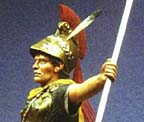 by Greg DiFranco
by Greg DiFranco
It was 211 BC and the two most powerful city-states of their time were locked in the mortal combat of the Second Punic War. It was the wealthy maritime power of Carthage pitted against Republican Rome. By now Carthage had brought Rome to the brink of total destruction, and arguably to the lowest point in its history. Hannibal and his fellow commanders had successfully defeated many Roman armies, and had completely annihilated a number of them in the process. Most notable was Hannibal’s annihilation of one of the largest armies Rome had ever assembled (70,000 troops) at the battle of Canne. Many of Rome’s most prominent citizens were lost in this battle, as in keeping with Republican Roman tradition, the most important citizens fought in the front ranks. The city of Rome itself was left almost helplessly exposed and was in chaos with the expectation of a siege. And if things weren’t desperate enough for the Romans, the Carthaginians now took complete control of Iberia (Spain), one of the most important economic areas of the region. In the process two of the most highly respected and admired Roman commanders were killed on the same day, they were the Scipio brothers. Although Rome fielded formidable armies, armies that in fact had beaten Carthage in the first Punic wars, they were proving no match for Hannibal’s troops and tactics. Rome fielded a non-professional citizen army with rather static legionary tactics based on breaking the enemy’s center, and without a strong cavalry contingent. On the other hand, Hannibal had successfully trained and honed an array of professional foot and mounted troops from African, Iberian (Spain) and Celtic stock, into a superior fighting force capable of flexible tactical maneuvers. To this he applied brilliant tactics, including classic flanking maneuvers the Roman legions were unable to counter.
Somehow, in the middle of the carnage that was Rome’s defeat at Canne, the young son of Scipio the Elder managed to survive. In an unprecedented move, the desperate Romans elected this young patrician to lead the remnants of the Roman army in Spain, he was just in his early twenties. Young Scipio immediately exhibited an uncanny ability for leadership and quickly set about retraining and improving the moral of the defeated Roman army of Spain. With the winter season as his respite, Scipio began laying plans for correcting the Roman legions weaknesses, and laying the groundwork for an army that could match Hannibal’s. No detail was left unattended, from the complex work of adding flexibility to legionary level tactics, to strengthening man to man fighting techniques, to details such as which sword would be most effective in close quarter combat.
 "Perhaps no other people have struck greater fear in the west than the Huns. In the end of the fourth century the Huns seemed to have materialized out of nowhere and crushed they way into the Hungarian plains. From there they extended their domains south of the Danube River, into Gaul and then northern Italy, leaving a trail of destruction and terror wherever they went.
"Perhaps no other people have struck greater fear in the west than the Huns. In the end of the fourth century the Huns seemed to have materialized out of nowhere and crushed they way into the Hungarian plains. From there they extended their domains south of the Danube River, into Gaul and then northern Italy, leaving a trail of destruction and terror wherever they went.
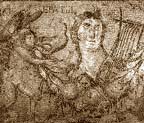 "The Yale University Art Gallery has acquired and will display five fragments of a Roman floor mosaic from Gerasa (now Jerash), a site in present-day Jordan that Yale excavated in association with the British in the 1920s and '30s. A fat garlanded boy sitting astride a panther, a partially nude maenad and two conversing satyrs are all part of the tableau of one of the five pieces of Roman mosaic recently acquired by the University art gallery."
"The Yale University Art Gallery has acquired and will display five fragments of a Roman floor mosaic from Gerasa (now Jerash), a site in present-day Jordan that Yale excavated in association with the British in the 1920s and '30s. A fat garlanded boy sitting astride a panther, a partially nude maenad and two conversing satyrs are all part of the tableau of one of the five pieces of Roman mosaic recently acquired by the University art gallery."
 By Mark Gustafson
By Mark Gustafson
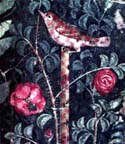 By M. Hoover, San Antonio College
By M. Hoover, San Antonio College
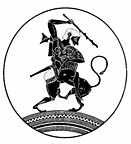 "A live performance of Homeric storytelling by Hugh Lupton and Daniel Morden (the acclaimed Iliad Project) will be the featured entertainment at the Triennial Meeting of the Greek and Roman Societies in Oxford, UK. The 'Triennial' is the highest-profile event in the UK classical calendar - at once a major classics conference and also a summer celebration of the subject in beautiful surroundings. Held alternately in Oxford and Cambridge, it brings together teachers, students and amateurs of classics from a comprehensive range of backgrounds and sub-disciplines. Plenary lectures of broad interest alternate with thematically designed discussion sessions centred round sets of shorter papers. Other sessions showcase the work of graduate students, and promote group discussion of selected classical texts, including some from the current A-level syllabus. "
"A live performance of Homeric storytelling by Hugh Lupton and Daniel Morden (the acclaimed Iliad Project) will be the featured entertainment at the Triennial Meeting of the Greek and Roman Societies in Oxford, UK. The 'Triennial' is the highest-profile event in the UK classical calendar - at once a major classics conference and also a summer celebration of the subject in beautiful surroundings. Held alternately in Oxford and Cambridge, it brings together teachers, students and amateurs of classics from a comprehensive range of backgrounds and sub-disciplines. Plenary lectures of broad interest alternate with thematically designed discussion sessions centred round sets of shorter papers. Other sessions showcase the work of graduate students, and promote group discussion of selected classical texts, including some from the current A-level syllabus. "
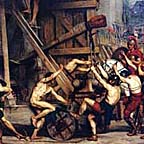 "The making of
"The making of  By Darren Kneen
By Darren Kneen
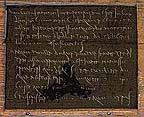 "A Roman writing tablet bearing the deed of sale of a slave, the first to be found in Britain, has gone on display at the Museum of London. Unearthed in 1996 by Museum of London archaeologists, the silver fir tablet contains 11 lines of text inscribed into black wax with a sharp metal stylus for a rich Roman bureaucrat over 2000 years ago.
"A Roman writing tablet bearing the deed of sale of a slave, the first to be found in Britain, has gone on display at the Museum of London. Unearthed in 1996 by Museum of London archaeologists, the silver fir tablet contains 11 lines of text inscribed into black wax with a sharp metal stylus for a rich Roman bureaucrat over 2000 years ago.